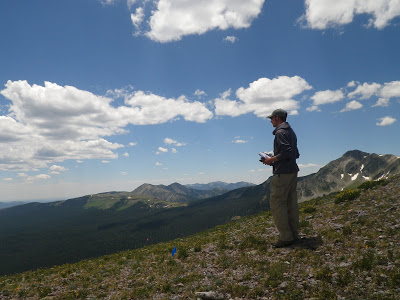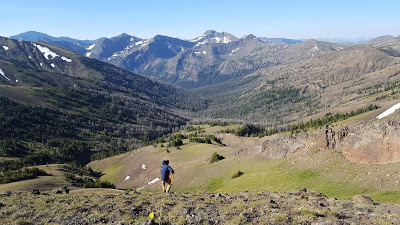By: Lydia Fahrenkrug and Gary Olds, CNHP Siegele Interns
Along with the New Mexico Heritage Program and the National Park Service, CNHP recently completed two important projects as a part of GLORIA. The Global Observation Research Initiative in Alpine Environments, GLORIA, is a project designed to monitor long-term changes in alpine tundra vegetation, soils, and temperatures. This global network assesses climate change impacts on the biological richness of the planet’s high mountain ecosystems, by monitoring four summits in a target region. The peaks have similar geology, climate disturbance, and land-use history, leaving vegetation differences among the summits to be driven primarily by elevation (Kuhn et al. 2014). After initial implementation, target regions are repeat sampled at least every five years.
 |
| Gary Olds in Pecos Wilderness Area. Photo taken by Lydia Fahrenkrug. |
The two target regions accomplished this summer include starting a GLORIA site in Pecos Wilderness Area, New Mexico (July 5-12) and repeat sampling in Yellowstone National Park, Wyoming (July 21-27). The trip began at Santa Barbara Trailhead, where the crew backpacked into No Fish Lake, the location of base camp all week. The crew consisted of Lydia Fahrenkrug, Dustin Gannon, Gary Olds, and Claire Tortorelli from CNHP, Hannah Burnham from New Mexico Heritage Program, and Brian Jacobs, a retired NPS botanist. Each day, they summited one of the four peaks, which were Chimayosos, West Chimayosos, North Truchas Peak and No Fish Peak to complete set-up and vegetation monitoring. With great weather and a hard working team, they were able to finish the project quickly and efficiently.
 |
|
|
The Yellowstone crew included Lydia Fahrenkrug, Alyssa Meier, Dustin Gannon, and Claire Tortorelli from CNHP, and Heidi Anderson and Monica Lomahukluh from the National Parks Service. They began in Shoshone National Forest and backpacked into their camping spot, which was on the border of Yellowstone National Park. Since this was a re-sample, all of the hardware was previously put in, allowing the crew to focus on the alpine vegetation. Everyone enjoyed the wonderful views and working together to complete this project, while wildflower season was in full swing.
 |
| Dustin Gannon measuring out for a plot in Yellowstone National Park. Photo by Alyssa Meier. |
These projects were successful thanks to funding from the Rocky Mountain Inventory and Monitoring Program of the National Park Service.
References
B., T. Talbot, and J. Stevens. 2013. Alpine vegetation composition, structure,
and soils
monitoring for Yellowstone National Park: 2011
Summary Report.




